

| Home | For sale | Site map | Contact information | Guest book | Stielhandgranate 24 menu |
 Stielhandgranate
24 Stielhandgranate
24  |
|---|
|
Packing material 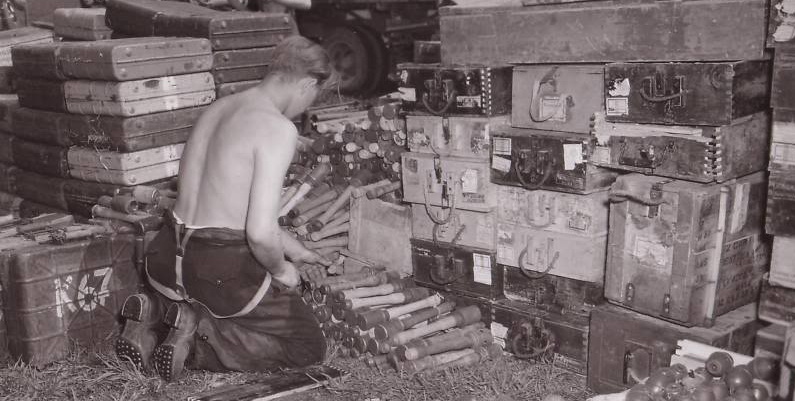 A german POW at work sorting and defusing grenades. Both models of the standard transport box are visible.  The Stielhandgranate 24 was shipped, handled and stored in an endless variety of boxes during the war. The early manuals mention two standard boxes; one made from steel, and one made of wood for storage, in addition "improvised use of boxes for shipping" was common ("Behelfsmässiger Verpackung"). The steel boxes contained 15 Stielhandgranaten 24, one box of 15 Brennzünder 24 and one box of 15 Sprengkapseln Nr. 8. Both due to stability and safety the handgrenades were not assembled until they had reached the units and were needed. If the Stielhandgranate 24 was shipped in a makeshift container, the detonators and fuses had to be shipped separately, in order to avoid accidents during shipping, I presume.  The metal suitcase  (Picture courtesy of Tom Ødemark) The steel model of the transport box was made like a suitcase. The official name was "Packkasten aus Blech für 15 Stielhandgranaten 24". It contained a separate rack that held the grenades in spring clips and had separate pockets for the detonators and fuses. If needed, the grenades could be carried in the rack alone. 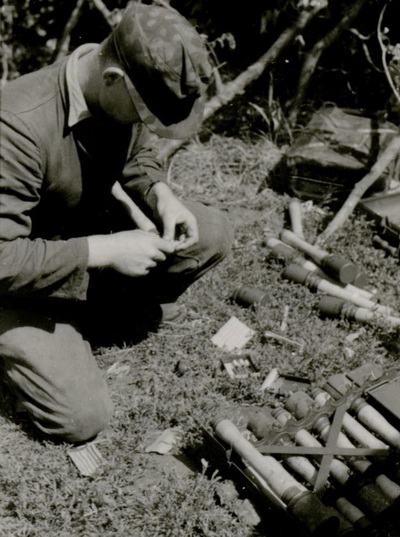 The above picture was taken by SS Kriegsberichter Büschel who covered the advance of 1st SS-Panzer Division Leibstandarte SS Adolf Hitler into Russia. The soldier is busy priming Stielhandgranaten 24. The corner of the empty suitcase can be seen to the right of the jerry can in the top of the picture. The rack still contains eight Stielhandgranaten, he is working on one and six are ready, lying in the grass. The open box of Brennzünder 24 is visible in the center of the picture. The metal suitcase was manufactured from the start of production of the Stielhandgranate 24 in 1924/25. Production appears to have stopped around 1944. It was painted ordnance green inside and out from the start, but changed to Dunkelgelb in 1943. Boxes with a white belly belt contained Nebelhandgranaten 39b. Late versions of the suitcase were only painted with red primer on the inside. Only very minor changes to the production design can be found from the very start to the end. The box normally carried information painted on it in white paint, which could be found "mirrored" on the inside. These details seem to have been fully replaced by glued on paper labels by 1943. 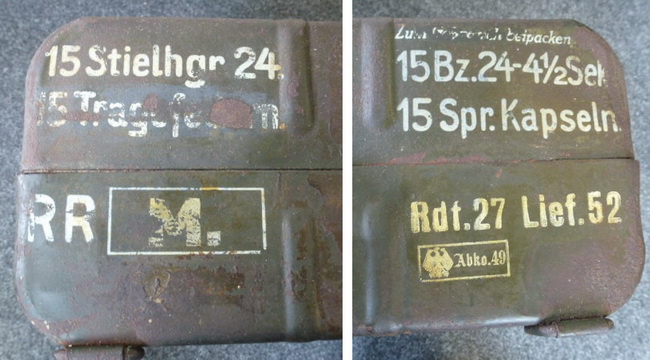 The box above is the earliest example I have found. It has the contents declaration which also includes "15 Tragefedern", fully described in the evolution section. It was filled with grenades made by Richard Rinker in 1927 (RRM), and the explosives came from Reinsdorf in 1927 from batch 52. This example is now in the collection of Tighe in the USA. The same type of box was also used for the Eierhandgranate 39 and the Wurfkörper 361 grenades for the Sturmpistole, the distinction made by the markings and the internal storage racks. 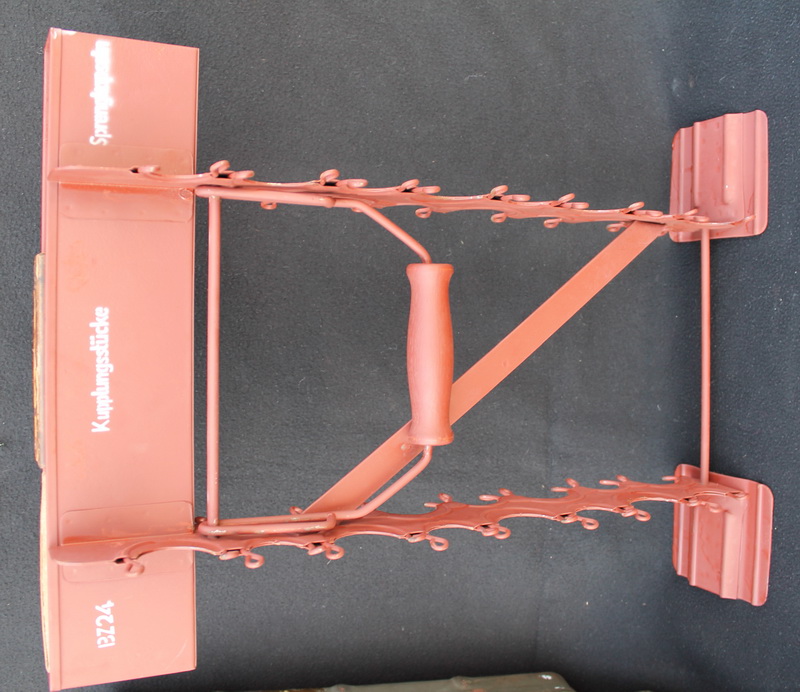 The rack stored inside the suitcase held the 15 Stielhandgranate 24 in spring clips, as well as boxes for the detonators and fuses. The official name for the rack was an "Einsatz". The Einsatz came in three different main varieties. 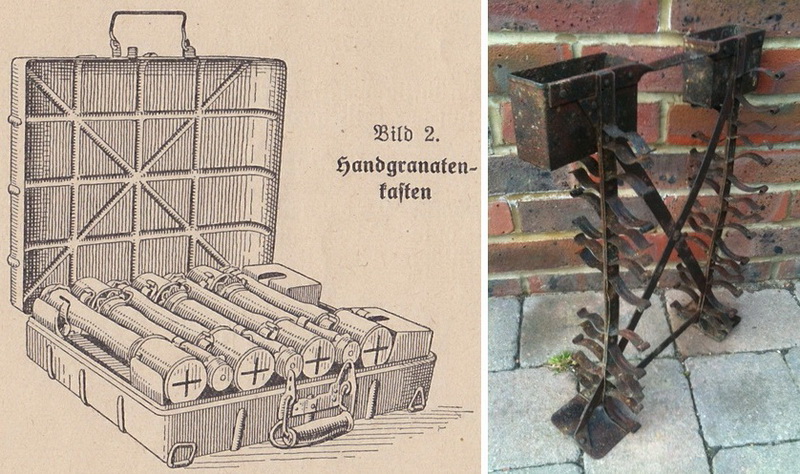 The first model had large flat springs that held the head and handle of the Stielhandgranate 24, and two containers for the boxes of detonators and fuses. It was pictured as a drawing in the "Waffentechnische Unterrichtsbuch" by Schmitt. The rack to the right above is owned by Nick Jeans. It has remained "un-identified" until now, but it certainly appears to be the first model of the Einsatz. 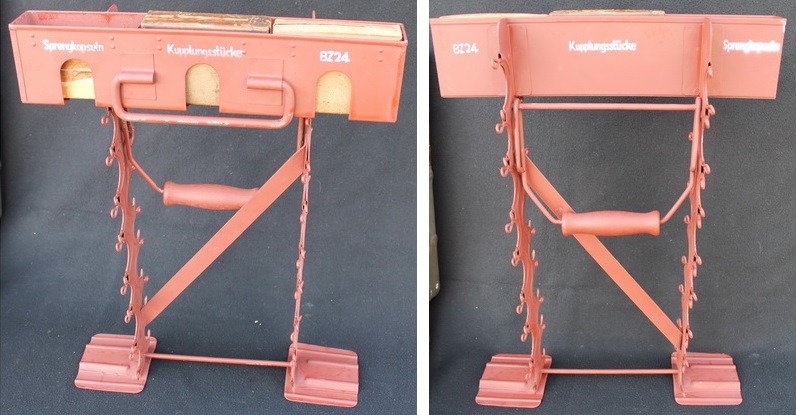 (Picture courtesy of Tom Ødemark) The second model of the Einsatz had simple wire springs that were sandwiched between two thin stamped steel plates, saving a lot of riveting compared with the first model. It had a simple swiveling steel wire handle to the side of the compartments. This was used to lift the rack out of the container or up from the ground. A second handle with a wood grip was placed at the top of the rack. It was retractable and was stowed when the rack was carried in the suitcase. The complete rack could be carried suspended from this handle all the way into combat if need be. The compartment on the top had three individual pockets for the boxes with detonators and fuses, each compartment had a cut out at the bottom and side to aid in removing the boxes. A pair of flat springs was riveted inside each compartment to add friction to the boxes so they stayed put until removed. Each compartment had the contents stenciled on both sides. The compartment in the middle contained "Kupplungsstücke", which translates to "coupling" or "adaptor". These items remain a mystery though. There is no piece missing for the assembly of the actual Stielhandgranate 24, so the Kupplungsstücke must have been an accessory. But there is no mentioning of this item in any of the contemporary publications, the closest I get is the "Spannmutter" which will be described on another page. The second model of the Einsatz came in two slightly different versions. The one pictured above had a singular compartment box with a separate box inserted in the middle as a divider, the other was made up of three identical boxes attached to each other. The Einsatz was normally painted in dark green, like the suitcase. The one above appears to have been factory refurbished, as it came with a fully labeled wc 1943 filled suitcase that was also primer red on the inside.  The other version of the second model was modular, made up of three identical boxes attached to each other. 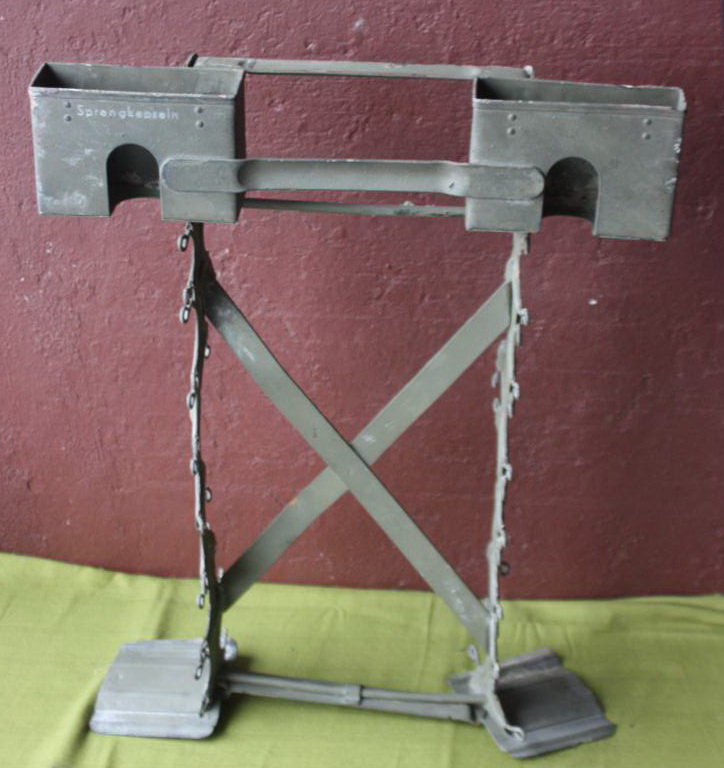 The third model was slightly simplified to save on raw materials and labor time. It was basically the same as the second model/second version, but the box in the middle for the Kupplungsstücke was dropped. The steel wire handle on the side of the compartments was dropped and replaced with a flat steel bar welded in position. The same happened with the retractable carrying handle, the whole mechanism was dropped and replaced with a flat steel bar. 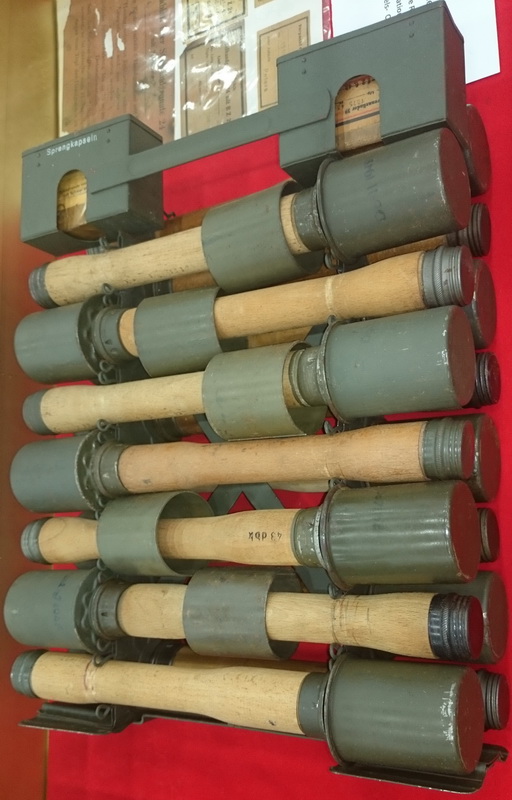 This second version of the third model appears to have been manufactured without the carrying handle on the top. This set was offered for sale on the SOS in 2015. 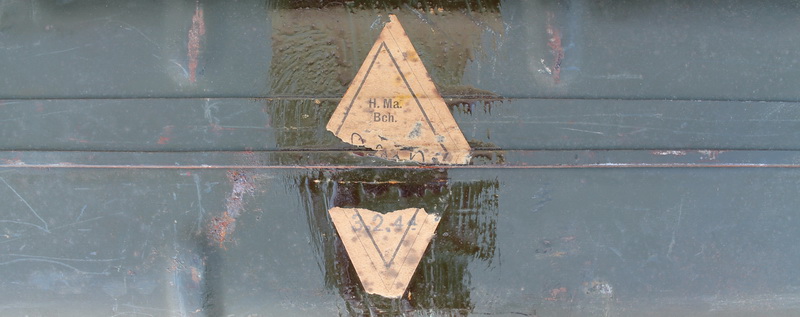 The metal suitcase was sealed by the factory with a glued on paper label. This box was sealed up on the third of February 1944. The wooden box 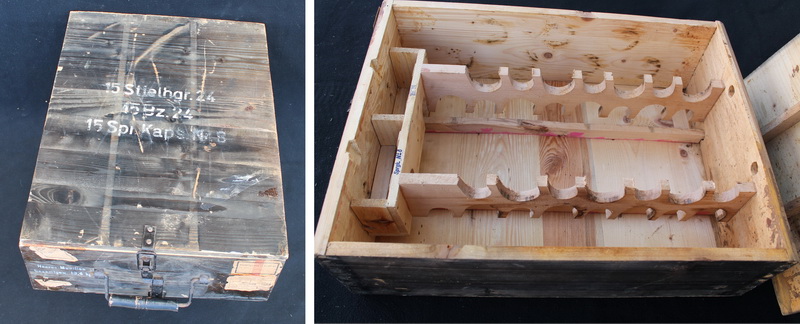 In order to save steel a wood version of the box was launched sometime into the war. The official name was "Packkasten aus Holz für 15 Stielhandgranaten 24". It had a detachable lid on both top and bottom and an internal rack that held the grenades. There were also two separate compartments for the boxes containing the fuses and detonators. The lids had no hinges. The cross members that held the lid planks together doubled as a support for the handles of the Stielhandgranate, and also acted as a hinge for the lid. 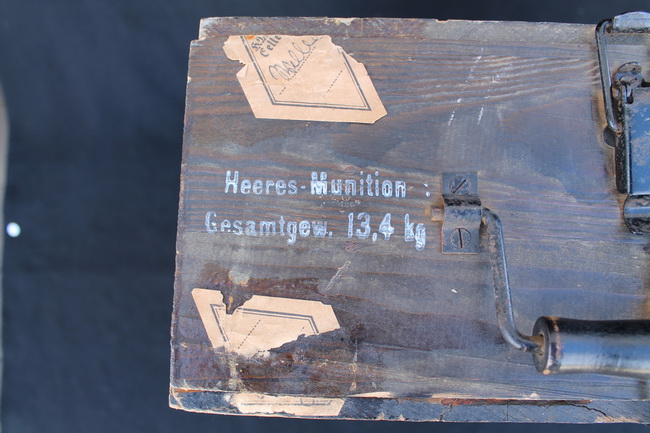 The wooden box was also sealed at the factory, but it took two labels, as it had two lids. 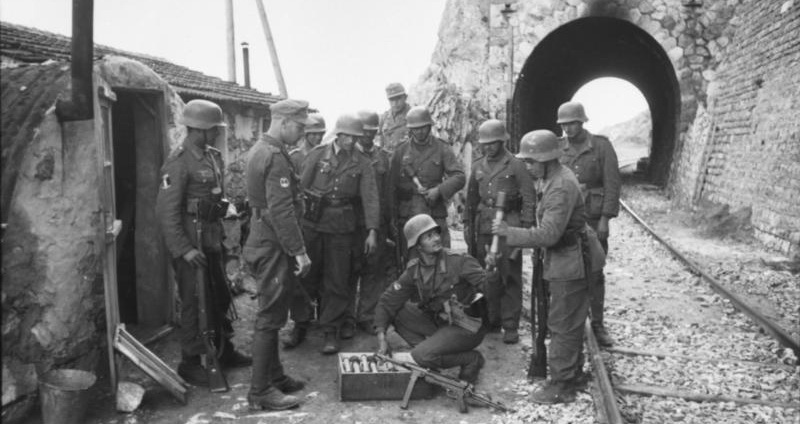 Autumn 1943. Stielhandgranaten 24 is distributed among soldiers of the Legion Freies Arabien in Greece. Note the lid for the wooden transport box that has been placed standing against the door of the hut. 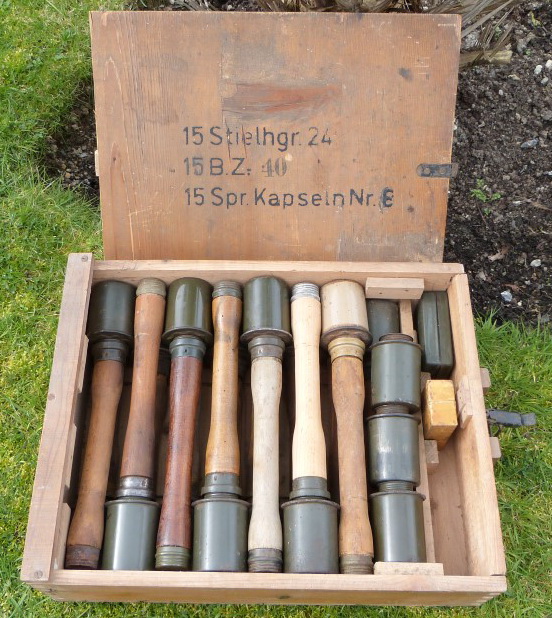 (Picture courtesy of Nick Jeans) The second model of the wooden transport box was again simplified. This box was constructed with only one lid and had almost no interior parts. The groves in the bottom (see picture below) corresponded with the crimped edge on the heads of either the Stielhandgranate 24 or the Stielhandgranate 43. A dividing wall was placed close to the top handle, holding the fuse and detonator boxes. 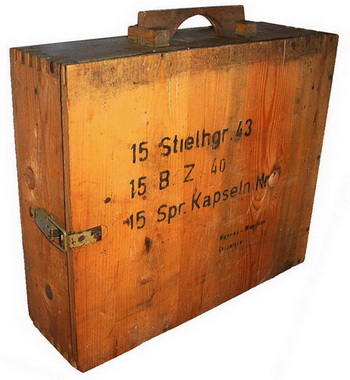 An alternative version of the second model had a fixed wooden carry handle on the top instead of the rope handle at the end. 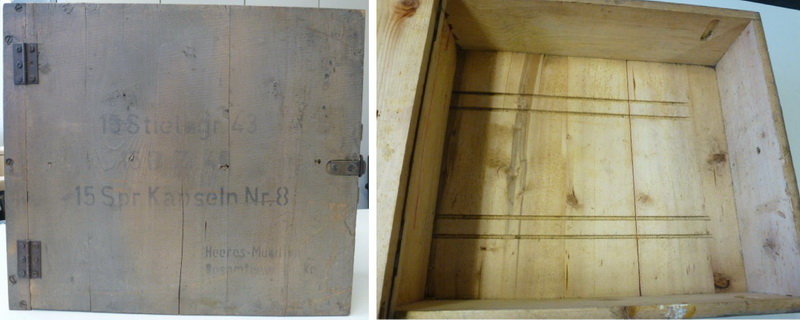 Although the box would accept both the Stielhandgranate 24 and Stielhandgranate 43 it would be painted on the lid which type it contained. The box above is missing the interior, and has had a set of hinges added to the lid. It is not known if this is a third version of this model, or if the hinges are (most likely) a postwar modification. Alternative boxes  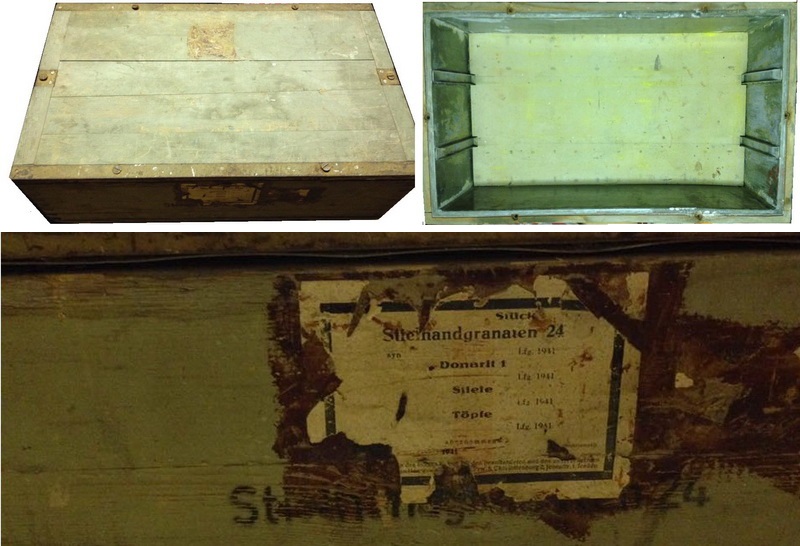 The Stielhandgranate 24 was delivered to the front in the battle packs of 15, as described above, filled by the manufacturers. But as a shipping method this was both ineffective and costly as the only solution. So alternative boxes with larger capacity were used. The Stielhandgranaten would then either be used to refill the battle packs behind the front line, or distributed directly to the users. In the occupied territories there was also a consumption of the Stielhandgranate for training purposes, and the need for extra battle packs wasn't there. The very rare box above was obviously purpose made for mass-transportation of the Stielhandgranaten 24, as the wood has the text stenciled on, under the factory added sticker. The capacity is not known, as the sticker covers the information. 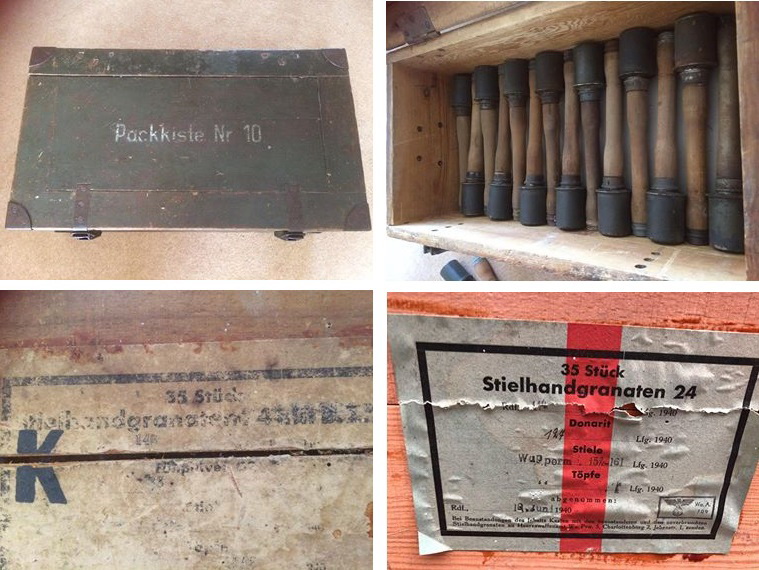 (Picture courtesy of Nick Jeans) The standard Packkiste Nr. 10 was also used as a makeshift transportation and storage container from the factory to the end user. The standard contents was 35 pieces. 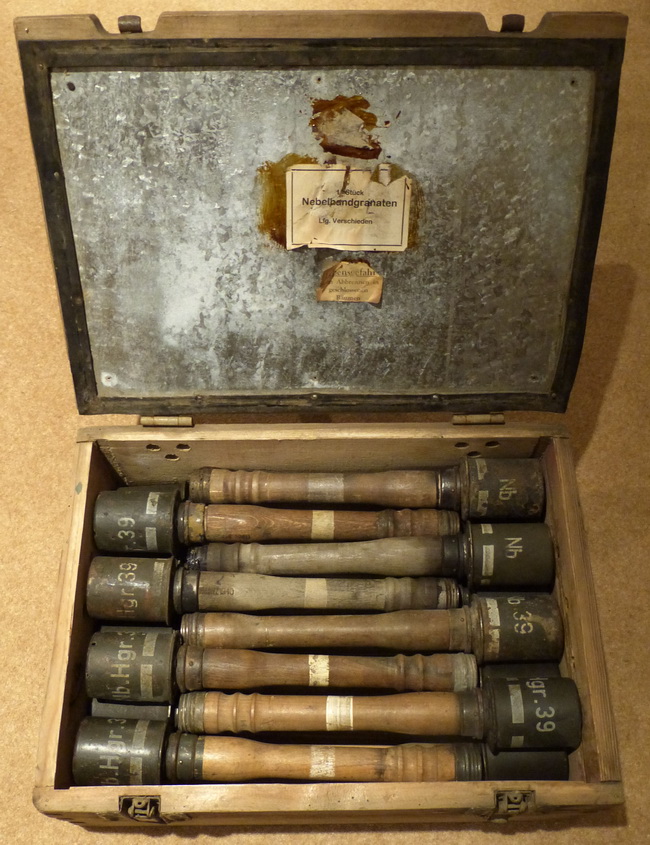 (Picture courtesy of Nick Jeans) Any box would do. The one above is a "Luftdichter Munitionskasten", a standard airtight ammunition box (liner missing), reused for the smoke handgrenade. Note the appropriate label under the lid; "16 Smoke handgrenades, Assorted lots" 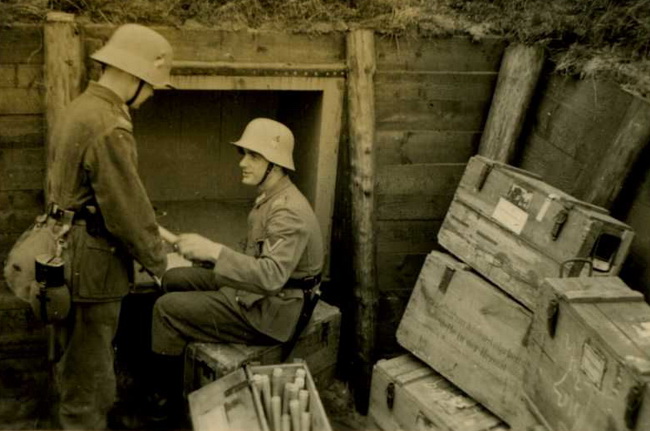 (Picture courtesy of Nick Jeans, UK) The above picture is from a prewar training. Un-primed Stielhandgranaten 24 are handed out from WW1 type transport boxes for the Stielhandgranate 15. 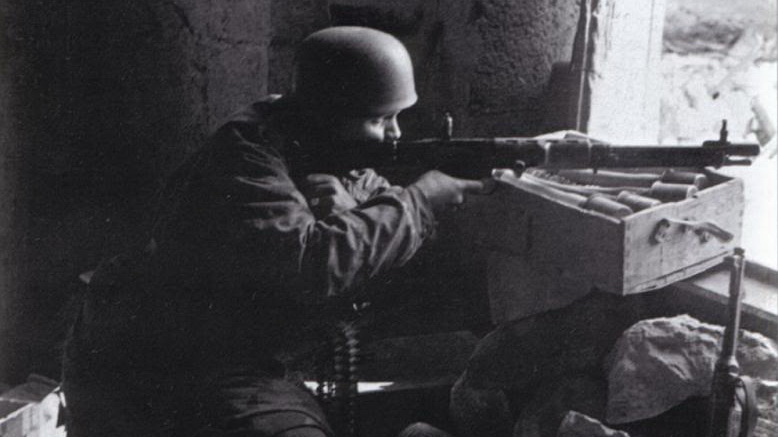 The grenades in this picture from Monte Cassino, early 1944, have been placed in a standard "Patronenkasten 88" box. The picture was taken by Kriegsberichter Wahner, who undoubtedly "arranged" the picture. The grenades actually belonged in a standard wooden box that is situated behind the gunner in the picture, and would not do well in the "line of fire". Transport & carrying methods 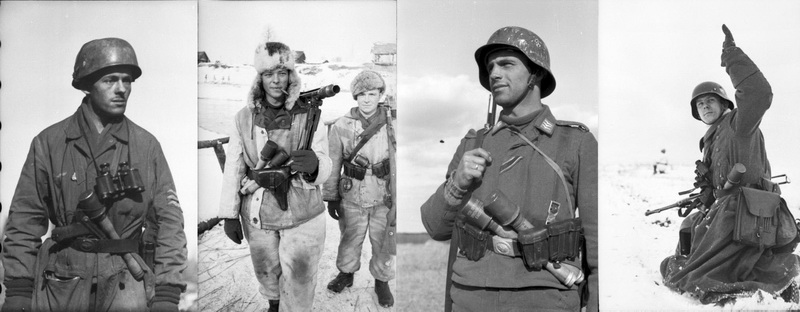 The normal way to transport the Stielhandgranat 24 was to tuck it inside the belt. 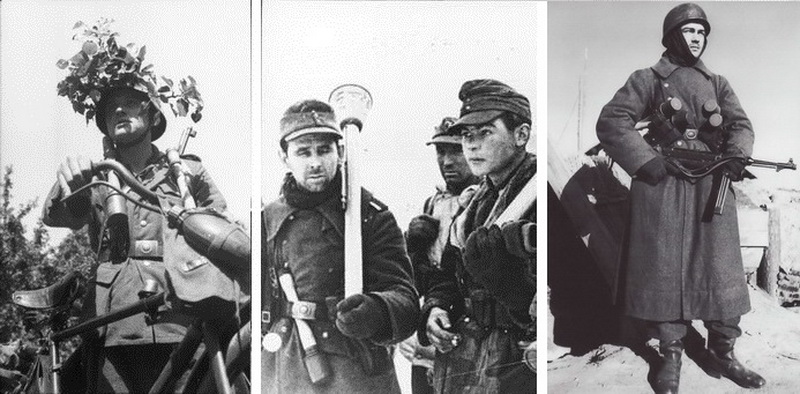 Other alternative carrying methods. The bicycle rider has tied a string to each handle and slung them around his neck. The Unterfeldwebel in the center picture has, very unusually, placed a grenade upside-down behind his belt. The Luftwaffe guard has tucked 4 grenades behind his Y-straps. 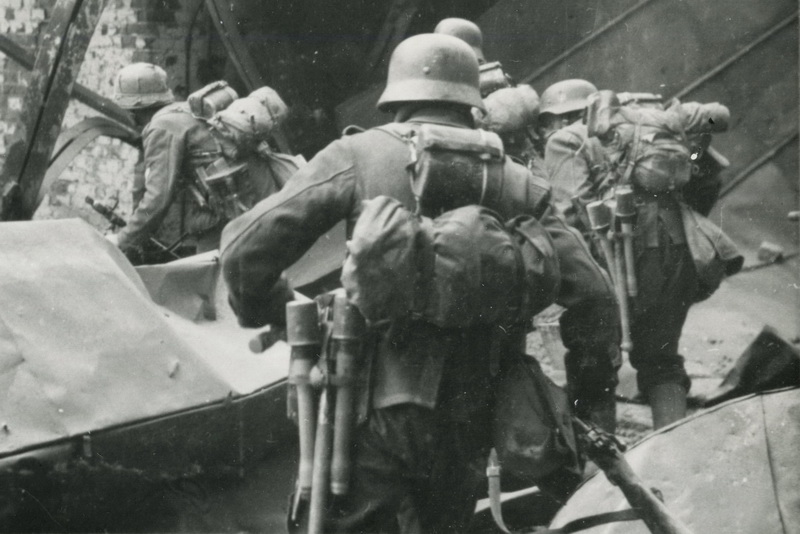 German infantry advancing through a ruined factory in Stalingrad. Note the carrying method for the Stielhandgranate 24 by the two soldiers closest to the camera. Both have slid them under the horizontal strap of the entrenching tool. 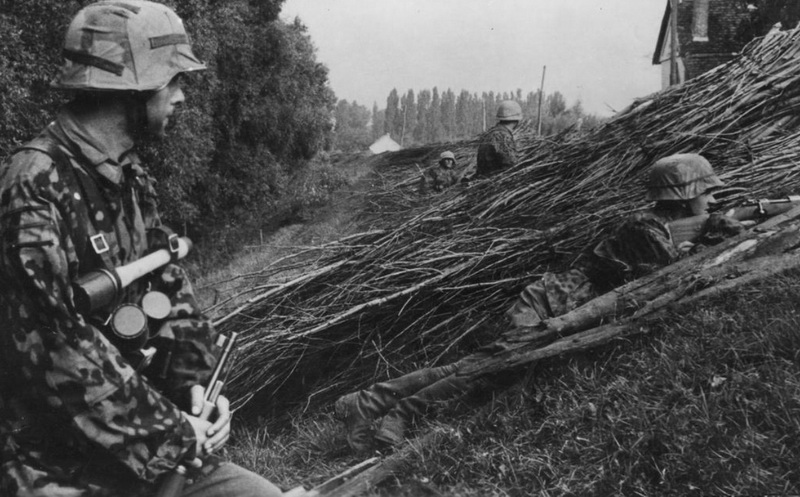 Yet another carrying method. This SS-Schütze has placed the handle inside the loops of the stabilizing straps attached to the front of the Y-straps. It is (possibly) fitted with a SS model Splitterring. He has also got two Stielhandgranate 24 tucked inside his belt, of which one has the Heer model Splitterring. 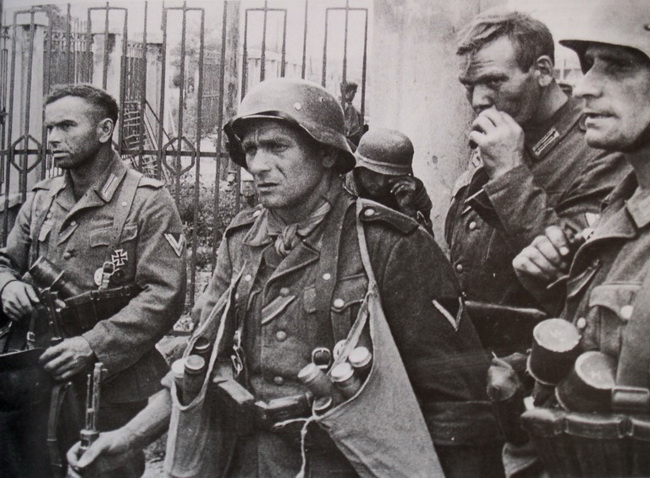 The traditional way of transporting "more Stielhandgranaten 24 than you could handle" was developed during the Great War. Two empty sandbags were tied or sewn together and carried under each arm, suspended from the neck by a strap. The same method was also used in WW II by Heer units, as pictured above. 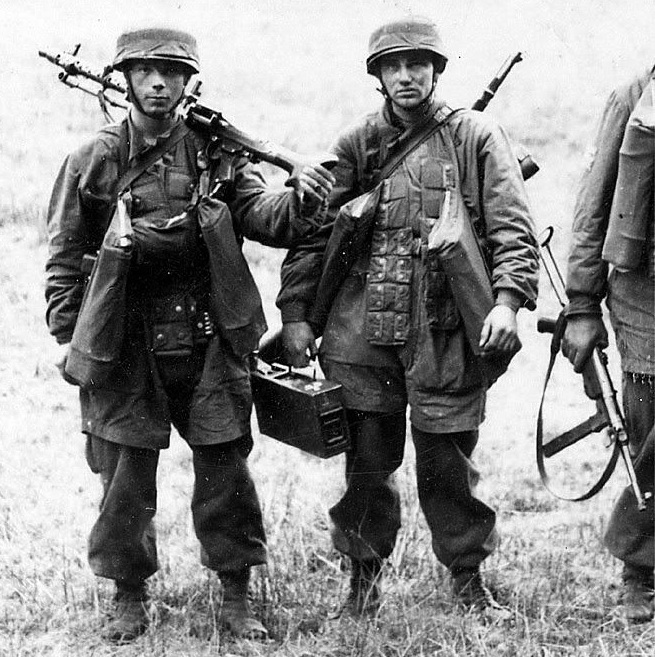 A set of specially constructed bags with zippered top existed, but appears to have been issued to Luftwaffe units (Fallschirmjäger) only. The set had a supporting strap that ran across the back in addition to the neck strap. All the Fallschirmjägers in the picture above carry a set of these pouches stuffed with Stielhandgranaten 24. Note the pouch on the man halfway out of the picture. The crimped edge of the Stielhandgranate 24 is clearly visible through the fabric, and also the fact that he has stuffed them in opposite directions in order to fill the pouches with as many as possible. Other points of interest are the differences in equipment. The man on the left carries an early MG34, and has a K98k ammunition bandolier with single snaps, and side-laced boots. The man in the middle also carries a K98k bandolier, but with double snaps, front laced boots and a MG34 double barrel carrier. 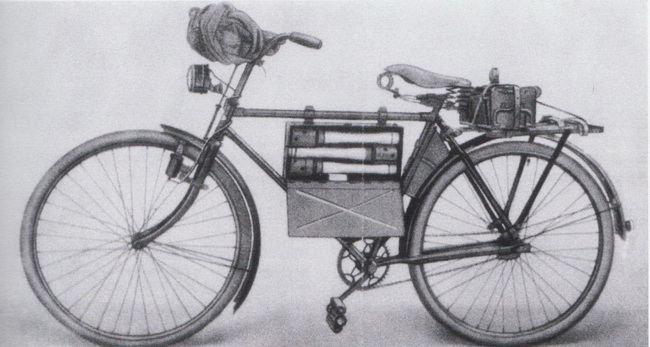 The German infantry bicycle had a box mounted within the frame that would take a box of 250 rounds of MG ammunition, or three Stielhandgranaten 24. In this picture from a temporary manual it is shown with the Übungsstielhandgranate 24. 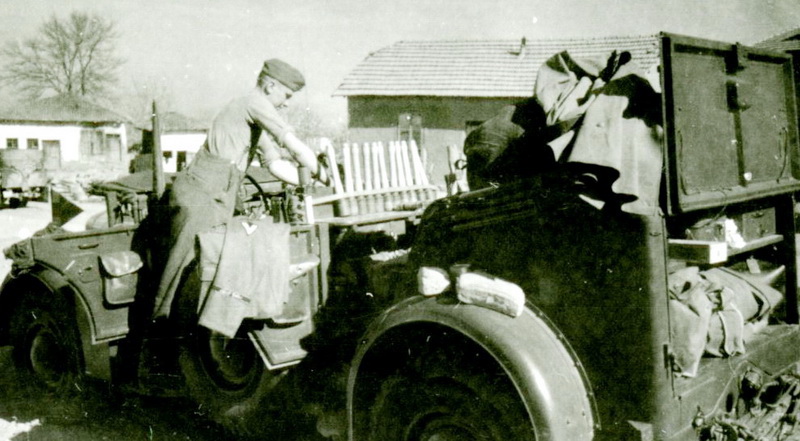 The above picture was taken by SS Kriegsberichter Weill in Russia 1941. It shows a vehicle from LAH stowed with Stielhandgranaten 24 in a rack. 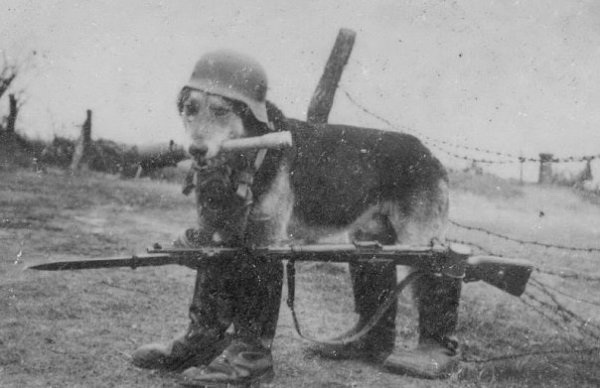 As long as the classical "Knobelbecher" marching boots with high shafts were distributed and used, the Stielhandgranaten could be worn inside the boot. 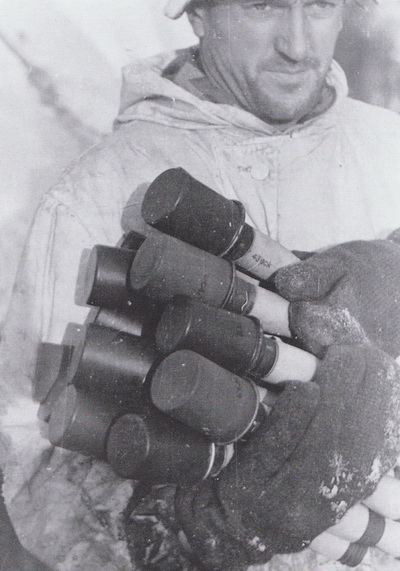 But at the end of the day, it all boils down to how much one can carry.....This soldier carries at least a dozen Stielhandgranaten 24. The one at the top was made by Metallwarenfabrik Siegwerk Gebrüder Schuppener, Siegen Westfalen in 1943. |
| Home | For sale | Site map | Contact information | Guest book | Stielhandgranate 24 menu |